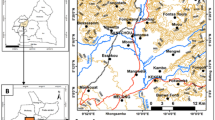Abstract
The main objective of this paper was to study the effect of precipitation on the geological development of badlands in arid regions. Field observations and laboratory investigations were carried out to characterize the surface soils of the Avonlea badlands in southern Saskatchewan, Canada, which is currently experiencing a rapid development in infrastructure. Three distinct surface sediments were identified: an upper slope of cemented sandstone, a mid-slope on weathered mudrock and a relatively flat basal pediment. Each of these soils reacts differently to rainfall events. Precipitation results in grain size reduction which, together with the consistency limits, explains the water sensitivity of the soils; the fines increased by 16% in the cemented sandstone, 78% in the weathered mudrock and 33% in the basal pediment. Erosion susceptibility was highest in the basal pediment (2% clays) followed by cemented sandstone (cementation by 6% active clays) and then by weathered mudrock (cohesion due to the 40% clay).
Résumé
Le principal objectif de cet article a été d’étudier les effets des précipitations sur le développement du ravinement et la formation des badlands dans les régions de climat aride. Des observations de terrain et des travaux de laboratoire ont été réalisés afin de caractériser les sols superficiels des badlands d’Avonlea, dans le sud-ouest du Saskatchewan au Canada, région qui connaît actuellement un important développement d’infrastructures. Trois différents matériaux de surface ont été identifiés : un grès cimenté de haut de pente, une argilite de milieu de pente et un dépôt de pédiment de bas de pente. Chacun de ces sols réagit différemment aux événements pluviométriques. Les précipitations ont pour conséquence une diminution de la taille des particules, ce qui, avec les indices de consistance, explique la sensibilité des sols à l’eau. Les particules fines augmentent de 16% dans les grès cimentés, de 78% dans les argilites altérées et de 33% dans les sédiments de pédiment. La sensibilité à l’érosion était plus élevée dans les sédiments de pédiment (avec 2% d’argiles) suivis par les grès cimentés (cimentés par 6% d’argiles actives) puis par les argilites altérées (présentant une cohésion du fait d’un pourcentage de 40% d’argiles).



Similar content being viewed by others
References
Azam S, Wilson GW, Herasymuik G, Nichol C, Barbour LS (2007) Hydrogeological behaviour of an unsaturated waste rock pile: a case study at the Golden Sunlight Mine, Montana, USA. Bull Eng Geol Environ 66(3):259–268
Bryan R, Yair A (1982) Badland geomorphology and piping. GeoBooks, Norwich
Cerdà A (2002) The effect of season and parent material on water erosion on highly eroded soils in eastern Spain. J Arid Environ 52(3):319–337
Christiansen EA (1979) The Wisconsinan deglaciation of Southern Saskatchewan and adjacent areas. Can J Earth Sci 116:913–938
Faulkner H, Alexander R, Wilson BR (2003) Changes to dispersive characteristics of soils along an evolutionary slope sequence in the Vera badlands, southeast Spain: implications for site stabilization. Catena 50:243–254
Imeson AC, Verstraten JM (1988) Rills on badland slopes: a physicochemically controlled phenomenon. Catena Suppl 12:139–150
Kasanin-Grubin M, Bryan R (2007) Lithological properties and weathering response on badland hillslopes. Catena 70:68–78
Potter PE, Maynard JB, Pryor WA (1984) Sedimentology of shale: study guide and reference source. Springer, New York
Regues D, Gallart F (2004) Seasonal patterns of runoff and erosion responses to simulated rainfall in a badland area in Mediterranean mountain conditions (Vallcebre, southeastern Pyrenees). Earth Surf Proc Land 29:755–768
Thomas DSG (1998) Arid zone geomorphology: process, form and change in drylands, 2nd edn. Wiley, New Jersey
Trimble DE (1980) Geologic story of the great plains. USGS Geological Survey Bulletin No. 1493
Warren A (1984) Arid geomorphology. Prog Phys Geogr 8:399–420
Acknowledgments
The authors would like to acknowledge the financial support provided by the Saskatchewan Ministry of Advanced Education and Employment. Thanks to the University of Regina for providing laboratory space and computing facilities. The help of Dr. Ulrike Hardenbicker during site visits is highly appreciated.
Author information
Authors and Affiliations
Corresponding author
Rights and permissions
About this article
Cite this article
Imumorin, P., Azam, S. Effect of precipitation on the geological development of badlands in arid regions. Bull Eng Geol Environ 70, 223–229 (2011). https://doi.org/10.1007/s10064-010-0300-4
Received:
Accepted:
Published:
Issue Date:
DOI: https://doi.org/10.1007/s10064-010-0300-4




